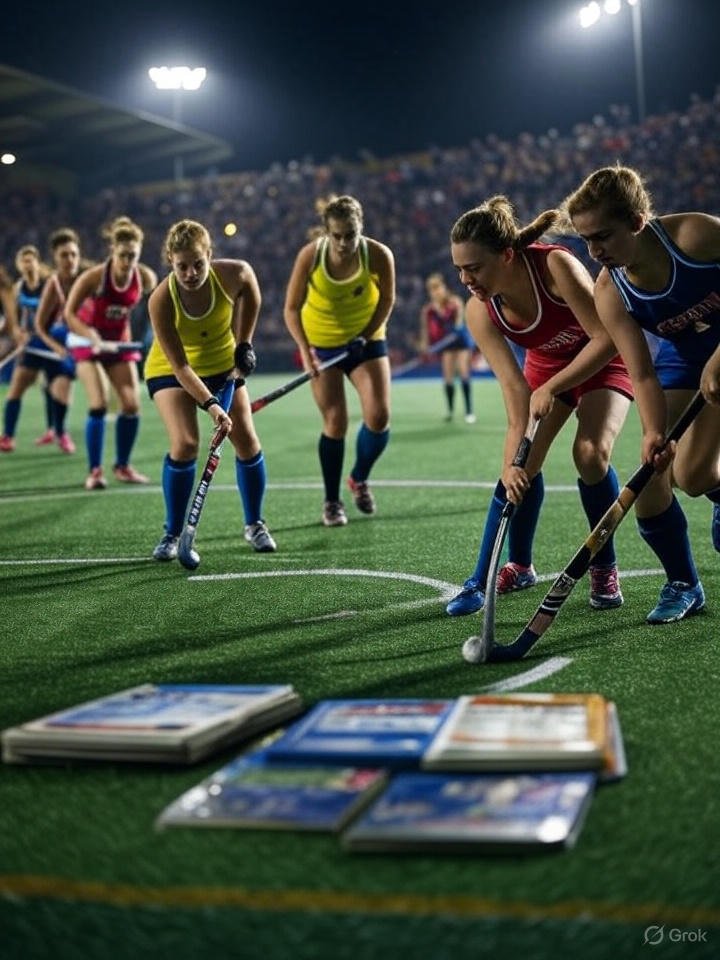In the shadow of football’s global dominance and basketball’s soaring popularity, field hockey quietly carves its own niche, blending speed, strategy, and skill into a game that’s as old as civilization itself. Once a cornerstone of international sports, field hockey has seen its fortunes wax and wane, yet recent years signal a remarkable comeback. From packed stadiums in India to grassroots movements in the United States, this sport is reclaiming its place on the world stage. This article explores the rich history, current revival, and promising future of field hockey, uncovering why it captivates players and fans alike in 2025.
A Game Rooted in Time
Field hockey’s origins stretch back over 4,000 years, with evidence of stick-and-ball games etched into the sands of ancient Egypt and carved into Greek pottery. By the Middle Ages, variations popped up across Europe, from the rough-and-tumble hockie in England to similar pastimes in Ireland and Scotland. The modern version took shape in the 19th century, thanks to British public schools, which formalized rules and spread the game through colonial outposts. The first international match unfolded in 1895 between Ireland and Wales, and by 1928, women’s field hockey joined the Olympic roster, cementing its global status.
For decades, field hockey thrived, particularly in countries like India and Pakistan, where it became a source of national pride. India’s golden era in the mid-20th century saw them clinch eight Olympic gold medals, a testament to their mastery of the game. Yet, as television brought new sports into living rooms and funding shifted elsewhere, field hockey’s prominence faded in some regions. By the late 1990s, it risked becoming a relic, overshadowed by the glitz of soccer and the slam-dunk allure of basketball. But the tide is turning, and the reasons are as diverse as the sport’s history.
The Spark of Revival
Today, field hockey is experiencing a renaissance, fueled by a mix of innovation, investment, and grassroots passion. One key driver is the evolution of the game itself. The introduction of artificial turf in the 1970s transformed its pace, making it faster and more dynamic, though it also raised barriers to entry due to costly facilities. Recent efforts to address this include portable turf systems and community programs, bringing the sport to urban parks and schoolyards. In India, the Hockey India League (HIL), launched in 2013 and revitalized in recent years, has injected fresh energy, drawing top talent and sellout crowds to matches in cities like Lucknow and Ranchi.
Technology plays a role too. High-definition broadcasts and social media highlights showcase the sport’s athleticism—players sprinting at 20 miles per hour, executing pinpoint passes, and diving for goals—winning over new audiences. The 2024 Paris Olympics, where India’s men’s team secured a bronze medal and the Netherlands dominated both genders, sparked a surge in interest, with viewership numbers climbing 30% from the previous Games. Young athletes, inspired by stars like Harmanpreet Singh or Eva de Goede, are picking up sticks, dreaming of their own Olympic glory.
In unexpected corners, the sport is finding new life. The United States, long a field hockey backwater, has seen a boom, especially among women. College programs at schools like North Carolina and Princeton draw thousands of spectators, while the national team’s consistent Olympic appearances—earning bronze in 2021—have sparked a youth movement. Clubs in California and Texas now host clinics, and the U.S. Field Hockey Association reports a 15% increase in registrations since 2022.
The Heart of the Game
What sets field hockey apart is its blend of physicality and finesse. Eleven players per side maneuver a hard ball with curved sticks, navigating a field longer than a football pitch. The game demands endurance—matches last 60 minutes—coupled with split-second decision-making. Defenders block shots with their bodies, midfielders orchestrate plays like chess masters, and forwards unleash powerful strikes. The penalty corner, a tense moment where a single shot can decide the outcome, keeps fans on edge.
Tactics add another layer. Teams employ formations like the 5-3-2 or 3-4-3, adapting to opponents’ strengths, while coaches analyze footage to exploit weaknesses. The sport’s inclusivity shines through too—mixed-gender leagues are gaining traction, and adaptive versions for wheelchair users are expanding access. This versatility keeps it relevant, appealing to a broad spectrum of players and spectators.
Challenges on the Horizon
Despite its resurgence, field hockey faces hurdles. The high cost of equipment—sticks can run $200 or more—and turf maintenance limits growth in low-income areas. In Africa and South America, where the sport has historical roots, development lags due to insufficient infrastructure. International governing body FIH (International Hockey Federation) is tackling this with initiatives like the Hockey5s format, a faster, simpler version played on smaller fields, designed to boost participation. Pilot programs in Kenya and Argentina have shown promise, with local leagues doubling in size over two years.
Another challenge is visibility. Unlike football or basketball, field hockey lacks a global superstar to carry the torch. While players like India’s Savita Punia or Australia’s Eddie Ockenden are legends in their circles, they’re not household names. Marketing efforts, including FIH’s “Hockey Revolution” campaign, aim to change that, using viral videos and celebrity endorsements to widen the audience. Still, breaking into the mainstream will take time and sustained effort.
A Bright Future
The future of field hockey looks promising, especially as sustainability becomes a global priority. The sport’s low environmental footprint—compared to golf or motorsports—aligns with eco-conscious values, attracting sponsors and organizers. The 2026 Youth Olympics in Dakar, featuring Hockey5s, could be a turning point, exposing millions of young athletes to the game. Meanwhile, virtual reality training tools are helping players hone skills affordably, leveling the playing field for emerging nations.
Community spirit also sustains the revival. In the Netherlands, where the sport boasts over 250,000 players, local clubs host festivals with music, food, and matches, drawing families and newcomers. In India, rural tournaments funded by corporate sponsors bring villages together, reviving traditions where elders once played barefoot on dirt fields. These events foster a sense of belonging, proving that field hockey is more than a game—it’s a cultural thread.
The global calendar offers more reasons for optimism. The FIH Pro League, an annual competition featuring top teams, draws millions of viewers online, while the 2028 Los Angeles Olympics will spotlight the sport on American soil. With rule tweaks—like reducing game time to attract casual fans—and investments in youth development, field hockey could soon rival more established sports in popularity.
Why It Matters
Field hockey’s resurgence is a story of resilience, a reminder that passion can breathe new life into old traditions. It offers a counterpoint to the commercialization of sports, emphasizing skill over spectacle. For players, it’s a chance to push physical and mental limits; for fans, it’s a thrill ride of strategy and surprise. As stadiums fill and new voices join the conversation, field hockey stands poised to reclaim its legacy, proving that some games are too good to fade away.
Whether you’re watching a penalty corner unfold or lacing up for your first match, this sport invites you into a world where history meets innovation. In 2025, with its roots deepening and branches spreading, field hockey is more than a comeback—it’s a celebration of what makes sports endure.





